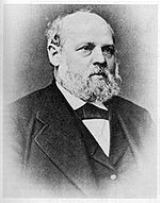
Heinrich Geissler
Encyclopedia
Johann Heinrich Wilhelm Geißler (May 26, 1814, Igelshieb
- January 24, 1879) was a German
physicist
and inventor of the Geissler tube
, a low pressure gas-discharge tube made of glass.
Geissler descended from a long line of craftsmen in the Thüringer Wald
and in Böhmen
. He found work in different German universities, eventually including the University of Bonn
. There he was asked by physicist Julius Plücker
to design an apparatus for evacuating a glass tube.
The future value of Plücker and Geissler's research 'toy' - apart from neon lighting
- would be fully realized only 50 years later when Lee De Forest
invented the Audion
vacuum tube
in 1906 ... creating the entire basis of long-distance wireless radio (and TV) communications.
Geissler was awarded an honorary doctorate in 1868.
Neuhaus am Rennweg
Neuhaus am Rennweg is a town in the district of Sonneberg, in Thuringia, Germany. It is situated in the Thuringian Forest, 17 km north of Sonneberg, and 22 km southwest of Saalfeld.-References:...
- January 24, 1879) was a German
Germany
Germany , officially the Federal Republic of Germany , is a federal parliamentary republic in Europe. The country consists of 16 states while the capital and largest city is Berlin. Germany covers an area of 357,021 km2 and has a largely temperate seasonal climate...
physicist
Physicist
A physicist is a scientist who studies or practices physics. Physicists study a wide range of physical phenomena in many branches of physics spanning all length scales: from sub-atomic particles of which all ordinary matter is made to the behavior of the material Universe as a whole...
and inventor of the Geissler tube
Geissler tube
A Geissler tube is an early gas discharge tube used to demonstrate the principles of electrical glow discharge. The tube was invented by the German physicist and glassblower Heinrich Geissler in 1857...
, a low pressure gas-discharge tube made of glass.
Geissler descended from a long line of craftsmen in the Thüringer Wald
Thuringian Forest
The Thuringian Forest running northwest to southeast, forms a continuous stretch of ancient rounded mountains posing ample difficulties in transit routing save through a few navigable passes in the southern reaches of the German state of Thuringia. It is about long and wide...
and in Böhmen
Bohemia
Bohemia is a historical region in central Europe, occupying the western two-thirds of the traditional Czech Lands. It is located in the contemporary Czech Republic with its capital in Prague...
. He found work in different German universities, eventually including the University of Bonn
University of Bonn
The University of Bonn is a public research university located in Bonn, Germany. Founded in its present form in 1818, as the linear successor of earlier academic institutions, the University of Bonn is today one of the leading universities in Germany. The University of Bonn offers a large number...
. There he was asked by physicist Julius Plücker
Julius Plücker
Julius Plücker was a German mathematician and physicist. He made fundamental contributions to the field of analytical geometry and was a pioneer in the investigations of cathode rays that led eventually to the discovery of the electron. He also vastly extended the study of Lamé curves.- Early...
to design an apparatus for evacuating a glass tube.
Plücker owed his forthcoming success in the electric discharge experiments in large measure to his instrument maker, the skilled glassblower and mechanic Johann Heinrich Wilhelm Geissler. He learned the art of glassblowing in the duchy of Saxe-MeiningenGeissler made a hand-crank mercury pump, and glass tubes that could contain a superior vacuum.Saxe-MeiningenThe Duchy of Saxe-Meiningen was one of the Saxon duchies held by the Ernestine line of the Wettin dynasty, located in the southwest of the present-day German state of Thuringia....
.... He finally settled down as an instrument-maker in a workshop of his own at the University of Bonn in 1852.
The future value of Plücker and Geissler's research 'toy' - apart from neon lighting
Neon lighting
Neon lighting is created by brightly glowing, electrified glass tubes or bulbs that contain rarefied neon or other gases. Georges Claude, a French engineer and inventor, presented neon tube lighting in essentially its modern form at the Paris Motor Show from December 3–18, 1910...
- would be fully realized only 50 years later when Lee De Forest
Lee De Forest
Lee De Forest was an American inventor with over 180 patents to his credit. De Forest invented the Audion, a vacuum tube that takes relatively weak electrical signals and amplifies them. De Forest is one of the fathers of the "electronic age", as the Audion helped to usher in the widespread use...
invented the Audion
Audion
An Audion is a wireless signal detector device invented by Lee De Forest in 1906.Audion may also refer to:* Audion , an electronic music album by Larry Fast* Audion , a media player for Apple Macintosh created by Panic...
vacuum tube
Vacuum tube
In electronics, a vacuum tube, electron tube , or thermionic valve , reduced to simply "tube" or "valve" in everyday parlance, is a device that relies on the flow of electric current through a vacuum...
in 1906 ... creating the entire basis of long-distance wireless radio (and TV) communications.
Geissler was awarded an honorary doctorate in 1868.

